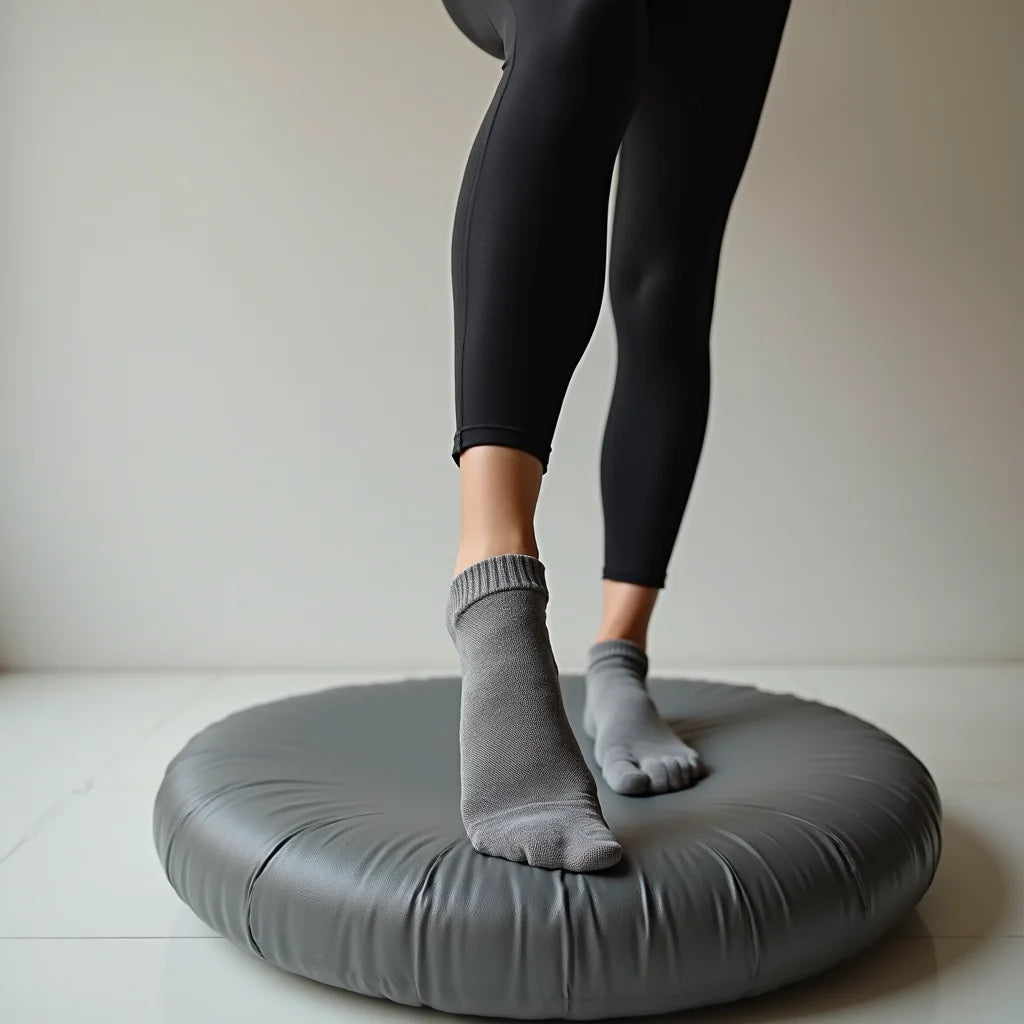Updated on: 2025-08-28
Table of Contents
- Introduction to pilates grip socks and non-slip benefits
- Essential tips for choosing pilates grip socks
- Grip patterns and materials that keep you stable
- Fit and arch support for comfort and control
- Hygiene and studio policies to know
- Versatility for barre and yoga classes
- Care and longevity tips
- Detailed step-by-step process to get the most from pilates grip socks
- Step 1: Choose the right style and coverage
- Step 2: Confirm the fit before class
- Step 3: Prepare your socks and your space
- Step 4: Use traction cues during class
- Step 5: Rotate pairs to extend lifespan
- Step 6: Wash and care for lasting grip
- Summary & takeaway on pilates grip socks
- Q&A: pilates grip socks, washing, sizing, and class etiquette
- About the author
Introduction to pilates grip socks and non-slip benefits
Pilates grip socks are a small upgrade that deliver big results. If you want steadier planks, smoother footwork on the reformer, and more confident balance on the mat, these socks give you traction where it counts. Non-slip Pilates socks and Pilates non-skid socks help you stay planted through lunges, pikes, and bridges, so you can focus on form rather than fighting slippage. They also support hygiene in shared studios and add a layer of comfort between your feet and the equipment. Whether you’re new or leveling up, the right pair will help you move with control.
In this guide, you’ll learn how to pick the best pilates grip socks for reformer classes, what grip patterns suit your practice, and how to care for your socks so they last. You’ll also see how these socks apply to barre and yoga, why arch support matters, and how to set up a simple routine that keeps your grip consistent from warm-up to cooldown.
Essential tips for choosing pilates grip socks
Grip patterns and materials that keep you stable
- Look for full-sole silicone grip patterns. These deliver traction across the heel, midfoot, and toes—ideal for the reformer carriage and box.
- Choose breathable cotton blends with a bit of stretch. This helps manage moisture without feeling bulky inside straps or foot cradles.
- Check the grip density. Denser dots under the heel and forefoot help during bridges, pikes, and standing balances.
- Explore styles that also work as barre grip socks or yoga grip socks if you cross-train. Versatility means fewer single-purpose items in your bag.
Fit and arch support for comfort and control
- Seek a snug, not tight, fit. If the sock twists, the grip can’t do its job.
- Prioritize pilates grip socks for women with arch support when you want a secure midfoot feel. A gentle compression band can reduce slipping inside the sock.
- Mind toe shape. Closed-toe designs feel cozy, while open-toe styles can improve tactile feedback on the reformer or mat.
- If you like a minimalist feel, ankle socks are solid for warm rooms; for cooler studios, crew height adds warmth without sacrificing traction.
Pro tip: If you prefer a value bundle to rotate through classes, consider the black 5-pack to keep a fresh pair ready every session.
Hygiene and studio policies to know
- Many studios encourage or require grip socks for shared-equipment hygiene. A dedicated pair helps keep your practice cleaner.
- Rotate at least two pairs so you always have a dry, clean set ready for your next class.
Versatility for barre and yoga classes
- If your week includes barre or yoga, choose a style that doubles as barre grip socks and yoga grip socks. You’ll get consistent traction on wood floors and mats.
- For balance-heavy sequences, prioritize forefoot and toe grip. For dynamic reformer work, go full-sole grip.
Many customers report that grip socks build confidence when they first try reformer. That added confidence often translates into better alignment and smoother reps. If you want a ready-to-go color set for multiple classes, explore the crew mixed 3-pack for a simple rotation and consistent traction across your week.

Care and longevity tips
- Turn socks inside out before washing to protect the grip.
- Use a gentle cycle, cold water, and a mild detergent.
- Air-dry flat. High heat can weaken silicone grip over time.
- Keep a spare pair in your gym bag so you never skip traction when one pair is drying.
Want to see the full range of colors and silhouettes? Browse the grip socks collection to find the fit and coverage that suits your routine.
Detailed step-by-step process to get the most from pilates grip socks
Step 1: Choose the right style and coverage
Start with a style that suits your studio and temperature. Ankle styles feel minimal and pair well with reformer straps. Crew styles add warmth and protect your Achilles when seated or kneeling. If you plan to use them for barre or yoga, choose a full-sole grip pattern that performs on smooth floors and mats.
Step 2: Confirm the fit before class
Put the socks on and test for heel slip or toe bunching. Walk a few steps, then hold a single-leg balance. If the heel stays put and you feel connected to the floor, the fit is right. A light arch band can help the sock hug the midfoot without pressure.
Step 3: Prepare your socks and your space
Before class, ensure your feet and the sock grips are dry. Wipe the reformer platform if needed. Dry grips work best and engage immediately when you place weight into the heel and forefoot.
Step 4: Use traction cues during class
Activate traction with intention. In footwork, press the heel into the carriage to feel the dots anchor you. For planks, spread your toes and root the ball of the foot. During standing splits, soften the knee slightly and center the weight so the grip can do its job without strain.
Step 5: Rotate pairs to extend lifespan
Alternate between at least two or three pairs. This rotation lets each pair air out and helps the silicone recover between sessions. Rotating also keeps your bag stocked for last-minute classes.
Step 6: Wash and care for lasting grip
Turn inside out, wash cold on a gentle cycle, and air-dry. Avoid high heat and fabric softeners. These simple steps help maintain traction and fabric structure, so your socks stay supportive and ready for your next session.
Summary & takeaway on pilates grip socks
Pilates grip socks turn slippery moments into stable movement. They’re practical for reformer, mat, barre, and yoga. Choose full-sole grip, a breathable fabric, and a fit that hugs the heel and arch. Rotate pairs and follow simple care steps to preserve traction. If you train multiple times a week, a mixed-color bundle makes it easy to keep a fresh pair ready while keeping your look coordinated. For ideas on building control with traction, explore more tips in this guide.
Q&A: pilates grip socks, washing, sizing, and class etiquette
Do I need grip socks for Pilates?
Grip socks are recommended in many studios because they improve traction and support hygiene on shared equipment. They help you stay stable on the reformer carriage, box, and mat, especially during standing work or planks. If your studio has a policy, bring a pair to every class. Even when optional, many people prefer the control and comfort they provide.
How do I wash and care for Pilates grip socks?
Turn your socks inside out, wash cold on a gentle cycle, and avoid bleach and fabric softeners. Air-dry flat or hang dry. Heat can reduce the effectiveness of silicone grip over time. Keeping a rotation of two or three pairs ensures you always have a clean, dry set ready for your next workout.
What size should I choose?
Pick your usual shoe size and follow the brand’s size chart if available. The sock should fit snugly with no heel slippage and no bunching at the toes. If you’re between sizes, many people prefer the smaller size for a more secure feel, particularly for reformer work where precise placement matters.
Are pilates grip socks also good for barre and yoga?
Yes. Styles designed as barre grip socks and yoga grip socks offer traction on polished studio floors and yoga mats. If you cross-train, look for a full-sole grip pattern to cover everything from relevés and pliés to vinyasa transitions and balance poses.
What are the best pilates grip socks for reformer classes?
Look for full-sole silicone grip, a breathable cotton blend, and a heel-hugging fit. Many people prefer crew styles for cooler rooms and ankle styles for a lighter feel. Bundles make it simple to rotate pairs while keeping a consistent fit and grip pattern across sessions.
About the author
Hot Eskimo Hot Eskimo crafts traction-forward grip socks designed for reformer, mat, barre, and yoga. We focus on comfort, durability, and consistent grip so you can train with confidence. Thanks for reading—here’s to more stable, more enjoyable movement in every class.
The content in this blog post is intended for general information purposes only. It should not be considered as professional, medical, or legal advice. For specific guidance related to your situation, please consult a qualified professional. The store does not assume responsibility for any decisions made based on this information.

